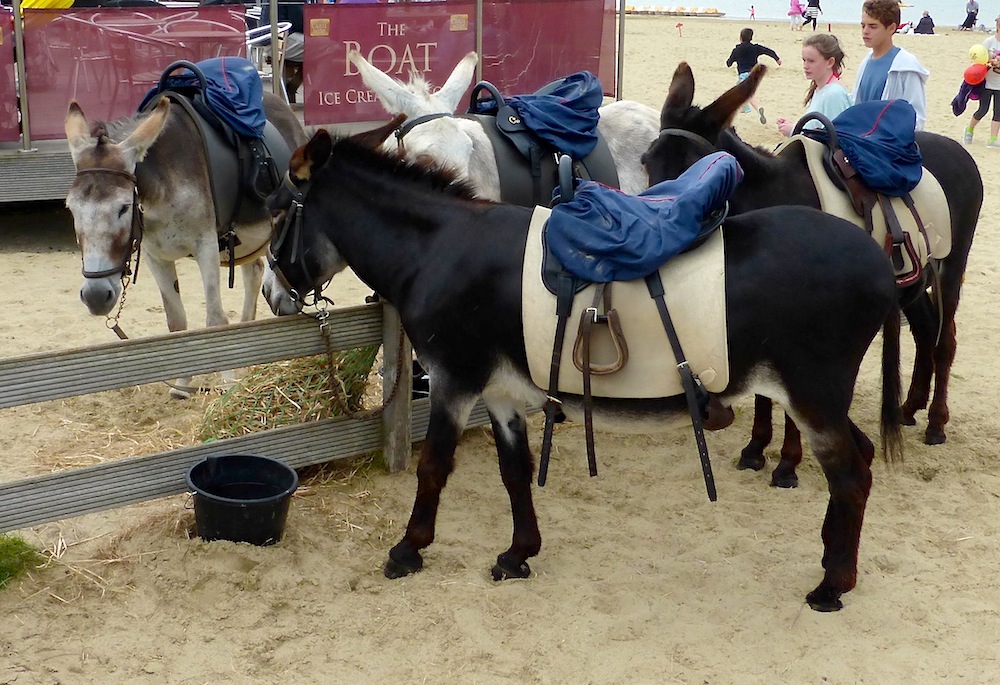Photographs by the author You may be use these images without prior permission for any scholarly or educational purpose as long as you (1) credit the photographer and (2) link your document to this URL in a web document or cite the Victorian Web in a print one. Click on the images to enlarge them.

The sea-front at Weymouth.
"Has any coast town a more spectacular seafront than Weymouth, the terraces continuous for half a mile, fronting the expanse of Weymouth Bay?" (Newman and Pevsner 453). This small town in Dorset, not far from Dorchester, has the good fortune to lie on a wide sheltered bay on the English Channel. Like a handful of other seaside towns, including Brighton in the south-east, its popularity was already established by Victorian times. Like Brighton too, Weymouth had the stamp of royal approval: George III often visited his brother at his grand house on the esplanade, Gloucester Lodge, in an attempt to regain his health in the sea air. The arrival of the railways in 1857 brought a new breed of holidaymakers flocking in. A Pictorial and Descriptive Guide to the area sums up its appeal, then as now: "Arrived on the 'Front,' with its noble curve, one quickly realizes the principal attraction of Weymouth, its splendid bay. Many of the houses on the Esplanade are pure Georgian, and with their genuine curved bow windows, red-brick façades, and red-tiled roofs, give the town a peculiar charm that is possessed by no other seaside resort" (12). By the end of the Victorian period, Weymouth had its colourful Jubilee clocktower (1887), a prominent statue of Queen Victoria (1896), and splendid new Royal Hotel (designed by Charles Orlando Law (1871-1918), and built 1897-99).



From left to right: (a) Houses along the front, offering holiday accommodation. The "genuine curved windows" are proudy on display. (b) St John the Evangelist's Church, at the junction of Greenhill and Dorchester Road, with Queen Victoria's statue presiding over the bay. (c) The Royal Hotel on the Esplanade.
Gloucester Lodge has been converted into flats, above The Gloucester public house, but the Royal Hotel is still in operation. It was advertised in the Pictorial and Descriptive Guide as "FACING the Beautiful and Picturesque Bay," and as being "Most Comfortable, Modern, and Well Furnished," with "Excellent Cuisine. Choicest Wines. Lift. Electric Light Throughout" — and as having "Perfect Sanitation" (facing p. ix). Hardy once lunched there with his wife on one of his later visits to the town (Holland 128). St John the Evangelist's church is also Victorian, having been designed by Thomas Talbot Bury (1809–1877), who studied with A.W.N. Pugin under the famous architect's father.



From left to right: (a) A bathing machine, preserved as a heritage item. (b) The splendid clock-tower erected in celebration of Queen Victoria's Golden Jubilee in 1887. (c) Close-up of the inscription.
Queen Victoria was not the first royal personage to avail himself of a bathing machine. During her time as Second Mistress of the Robes to Queen Charlotte, Fanny Burney records how George III fared when he tried it here: "Think but of the surprise of His Majesty, when the first time of his bathing, he had no sooner popped his Royal head under the water, than a band of music, concealed in a neighbouring machine, struck up 'God save great George our King!'" (qtd. in Hill 297). The King, says Burney, soon gave up the experiment. But most of those who went bathing in what came to be called, rather comically, "the English Bay of Naples," had a less eventful experience. They could also enjoy Punch and Judy shows and donkey rides on the beach, or take a pleasure boat. They could explore other parts of the coast or, if they liked longer trips, venture as far as the Channel Islands.



From left to right: (a) Punch and Judy on the beach, still popular today. (b) Mr Punch, from the Dorchester Museum. (c) Donkey rides, also still popular today.
Weymouth and nearby Lulworth Cove have several literary associations, but the pre-eminent one is with Thomas Hardy, who calls it Budmouth or Budmouth Regis, notably in The Trumpet Major. Early in his career as an architect, Hardy had spent some months here, taking advantage of all the resort had to offer, "bathing at seven in the morning and rowing in the bay almost every evening in the summer; in winter he enjoyed a quadrille class" (Pinion 6). The young architect was writing too, both poetry and prose — much of his first novel, Desperate Remedies, was written here. On one of his later visits, he attended John Drinkwater's adaptation of the The Mayor Casterbridge in Weymouth: "He met with a wonderful reception in the theatre, the people rising and cheering and clapping their hands and waving handkerchiefs, and very much the same reception outside the Pavilion Theatre on the pier at the close of the performance" (Holland 237).
Links to related material
- Never-Land, Lulworth Cove and the Intellectual Circles of J. M. Barrie, Thomas Hardy, Alfred Fripp, Sir Frederick Treves and Gerald Du Maurier
- Thomas Hardy's Other Career, as an Architect
- Seaside in the Victorian Literary Imagination
- The Development of Leisure in Britain, 1700-1850
- The Development of Leisure in Britain after 1850
Bibliography
Darton, F. J. Harvey. The Soul of Dorset. Boston: Houghton Mifflin, 1922. Internet Archive. Contributed by Robarts Library, University of Toronto. Web. 1 January 2023.
Hill, Constance. Fanny Burney at the Court of Queen Charlotte. London: John Lane, the Bodley Head, 1912. Internet Archive. Contributed by University of California Libraries. Web. 1 January 2023
Holland, Clive. Thomas Hardy, OM. New York: Haskell House, 1966.
Newman, John, and Nikolaus Pevsner. Dorset. New Haven and London: Yale University Press, 2002.
A Pictorial and Descriptive Guide to Weymouth, Portland, Dorchester, Lulworth, Swanage, Sherborne, etc. 6th ed., revised. Ward, Lock and Company, Ltd, 1921. Internet Archive. Contributed by University of California Libraries. Web. 1 January 2023.
Pinion, F.B.
Created 1 January 2023